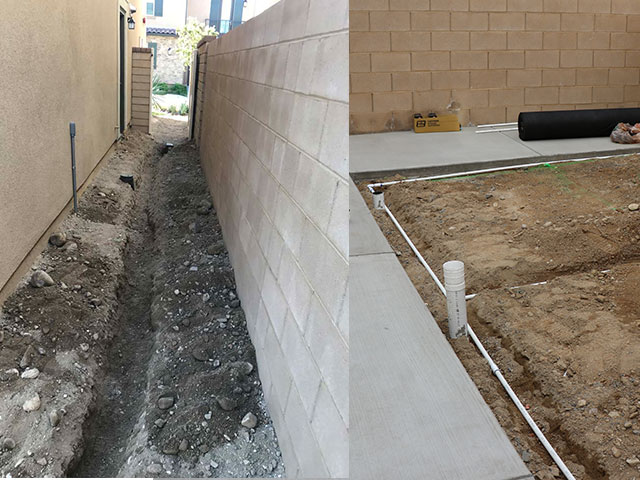 What to know about yard drains for proper drainage
What to know about yard drains for proper drainage
Back in the days when you could buy a house that sat on an acre of land, there was no need for yard drains. Here in Los Angeles and local newer communities such as Santa Clarita, yard drains are almost a necessity. Regardless of the soil types present in your area, the subsurface drain is still almost always a necessity. For the most part, as the land grows increasingly harder to acquire, the houses have to thus be built on smaller lots. Subsequently, the smaller the lot the less opportunity the homeowner has to facilitate drainage away from the building. Thus reducing the potential for water intrusion.
There are multiple different ways to achieve proper drainage around the perimeter of the home, for example:
- Subsurface drainage
- Solid surfaces such as concrete
- Swales within the parameters of the yard
- Sump pumps
What does the Los Angeles County Building Code say about yard drains for proper drainage?
R401.3 Drainage. Surface drainage shall be diverted to a storm sewer conveyance or other approved point of collection that does not create a hazard. Lots shall be graded to drain surface water away from foundation walls. The grade shall fall a minimum of 6 inches (152 mm) within the first 10 feet (3048 mm). Exception: Where lot lines, walls, slopes or other physical barriers prohibit 6 inches (152 mm) of fall within 10 feet (3048 mm), drains or swales shall be constructed to ensure drainage away from the structure. Impervious surfaces within 10 feet (3048 mm) of the building foundation shall be sloped a minimum of 2 percent away from the building.MAZZA
Not only is proper drainage suggested, but it’s also required. The local building code is very clear about the requirements which facilitate yard drainage.
Regardless of whether you think subsurface drains are necessary, proper lot drainage, however, is a necessity. As you can see, the building code stipulates the direction of water flow as well as the distance needed to facilitate such drainage. Whether the surface is solid or soil, the building codes still covers all surfaces.
Where to install subsurface yard drains for proper drainage
When we think about digging trenches around your house the task may appear on its face to be daunting. Fear not… there are tools that can make this task easy. Tools such as the Ditchwitch for example, make digging trenches as easy as walking. Subsurface drains will typically get installed up to 18″ below the surface. The lot size and distance will generally dictate the overall depth. Companies like patiocovered.com provide services such as yard drains for proper drainage. In the event that proper “drop” cannot be achieved from the front to the back, alternative means of achieving drainage such as the use of sumps can be used as well.
Home purchases… the need to check yard drains for proper drainage
 Sooner or later, your yard drains will either become clogged with debris or damaged from root intrusions. For new home buyers, having damaged or blocked subsurface drains can not only be catastrophic, but extremely costly. Think about this; subsurface drains are well, subsurface. Therefore, any solid surfaces such as concrete will have to be removed and replaced to facilitate the replacement of the damaged drains.
Sooner or later, your yard drains will either become clogged with debris or damaged from root intrusions. For new home buyers, having damaged or blocked subsurface drains can not only be catastrophic, but extremely costly. Think about this; subsurface drains are well, subsurface. Therefore, any solid surfaces such as concrete will have to be removed and replaced to facilitate the replacement of the damaged drains.
MAKE SURE YOUR HOME INSPECTOR CHECKS THE DRAINS. AT THE VERY MINIMUM, RUN WATER THROUGH THE DRAINS.



Share this Post

